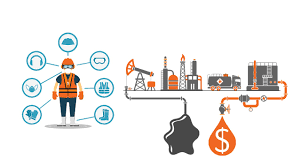Safety is a top priority in every industry, but it holds particular significance in the oil and gas sector. The extraction, refining, and transportation of oil and gas come with inherent risks, making stringent safety measures crucial to protecting workers and the environment. This article delves into the importance of oil and gas safety, highlighting key practices, regulations, and technologies that ensure a secure workplace in this vital industry.
Why Oil and Gas Safety Matters:
Protection of Workers: The oil and gas industry involves various hazardous activities, including working with heavy machinery, handling volatile substances, and operating in remote or offshore locations. By prioritizing safety protocols, companies can safeguard their employees from accidents, injuries, and potential fatalities. Ensuring workers' well-being fosters a positive work environment and improves productivity.
Environmental Preservation: Oil and gas operations can have significant environmental impacts if safety measures are not in place. Spills, leaks, and accidents can lead to soil and water contamination, air pollution, and damage to ecosystems. By implementing robust safety practices, companies minimize the risk of incidents that could harm the environment, promoting sustainability and responsible resource management.
Reputation and Stakeholder Confidence: Companies operating in the oil and gas industry face scrutiny from stakeholders, including investors, regulators, and the public. Demonstrating a strong commitment to safety builds trust, enhances reputation, and attracts responsible investors. It also strengthens relationships with local communities, who rely on the industry for employment and economic growth.
Key Practices for Oil and Gas Safety:
Comprehensive Risk Assessments: Conducting thorough risk assessments is crucial in identifying potential hazards and developing appropriate mitigation strategies. Assessments should consider all aspects of operations, including equipment, processes, human factors, and external factors such as weather conditions. Regular reviews and updates to risk assessments ensure they remain effective as operations evolve.
Rigorous Training and Competency Programs: Properly trained and competent workers are essential for maintaining a safe work environment. Companies should invest in training programs that cover safety procedures, emergency response, hazard recognition, and the proper use of personal protective equipment (PPE). Ongoing training and refresher courses keep employees updated on the latest safety practices.
Effective Safety Management Systems: Establishing robust safety management systems (SMS) is vital for promoting a safety culture. An SMS includes clear safety policies, procedures, and protocols, as well as effective incident reporting and investigation processes. Regular audits and inspections ensure compliance with safety standards and facilitate continuous improvement.
Hazardous Material Handling: Proper handling, storage, and disposal of hazardous materials are critical to preventing accidents and environmental damage. Employing best practices, such as appropriate labeling, containment, and spill response procedures, reduces the risk of leaks or spills that could harm workers or contaminate the surrounding environment.
Technological Advancements Enhancing Oil and Gas Safety:
Remote Monitoring and Automation: Advanced sensors and monitoring systems enable real-time tracking of equipment performance, detecting anomalies, and predicting failures. This data-driven approach minimizes the risk of accidents caused by equipment malfunctions and enables proactive maintenance.
Drones and Robotics: Unmanned aerial vehicles (UAVs) and robots equipped with cameras and sensors can be deployed for inspections, reducing the need for workers to perform high-risk tasks. Drones provide a comprehensive aerial view of sites, facilitating efficient monitoring and identifying potential safety hazards.
Virtual and Augmented Reality (VR/AR): VR/AR technologies offer immersive training experiences, allowing workers to simulate hazardous scenarios in a controlled environment. This enhances their ability to respond to emergencies and improves hazard recognition skills, all while minimizing real-world risks.
Conclusion:
Oil and gas safety is an essential aspect of the energy industry, protecting workers, the environment, and the reputation of companies operating within the sector. By implementing comprehensive risk assessments, robust safety management systems, and leveraging technological advancements, companies can create a secure workplace environment. Prioritizing safety not only prevents accidents and environmental incidents but also enhances stakeholder confidence and promotes sustainable practices. With a continued focus on safety practices and ongoing innovation, the oil and gas industry can mitigate risks and ensure the well-being of its workforce while contributing to global energy needs.

